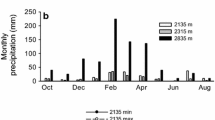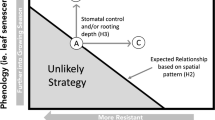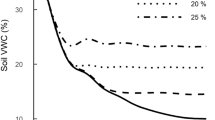Summary
In the alpine zones of western North American mountains, topographic-moisture gradients are the results of winter winds blowing snow from the upper windward slopes and ridgetops into snowdrifts on the lee slopes. Wet meadows at the foot of the lee slope are the result of summer snowmelt. Such gradients are repeated many times in a single mountain range. They are useful units for studies of the effects of drought and water use on patterning of alpine vegetation.
The research was done through an entire growing season along a topographic gradient at 3,300 m in the Medicine Bow Mountains, Wyoming. Plant water potentials were measured on 29 species (pre-dawn to sunset) at weekly intervals. Simultaneously, leaf conductances were measured on 16 species of these; the remainder had leaves too small for the porometer. Leaf water potentials were generally lowest on the ridgetop and highest in the wet meadow. Highest mean leaf conductances were in the wet meadow plants; the lowest occurred on plants on the upper windward slope. None of the plants on the ridgetop had leaves large enough for the porometer. Plants of most species at all sites but the wet meadow showed sharply reduced leaf conductance or leaf death at plant water potentials below-1.5 MPa. Deep-rooted species such as Trifolium parryi showed maximal conductance at water potentials as low as-1.7 MPa and little reduction in conductance even at lower water potentials. Plant water potentials and leaf conductances showed close relationships with rooting depth, length of dry periods, and position on the gradient.
Similar content being viewed by others
References
Billings WD, Bliss LC (1959) An alpine snowbank environment and its effects on vegetation, plant development, and productivity. Ecology 40:388–397
Billings WD, Mooney HA (1968) The ecology of arctic and alpine plants. Biol Rev 43:481–529
Billings WD (1973) Arctic and alpine vegetations: Similarities, differences, and susceptibility to disturbance. Bioscience 23(12):697–704
Bliss LC (1956) A comparison of plant development in microenvironments of arctic and alpine tundras. Ecol Monogr 26:303–337
Chabot BF, Billings WD (1972) Origins and ecology of the Sierran alpine flora and vegetation. Ecol Monogr 42:163–199
Courtin GM, Mayo JM (1974) Artic and alpine plant water relations. In: J Vernberg (ed), Physiological adaptation to the environment. Intext Educational Publications, New York pp 201–224
Daubenmire RF (1941) Some ecologic features of the subterranean organs of alpine plants. Ecology 22:370–378
Ehleringer JR, Miller PC (1975) Water relations of selected plants in the alpine tundra, Colorado. Ecology 56:370–380
Hellkvist J, Richards GR, Jarvis PG (1974) Vertical gradients of water potential and tissue water relations in Sitka spruce trees measured with the pressure chamber. J Appl Ecol 11:637–667
Klikoff LG (1965) Photosynthetic response to temperature and moisture stress of three timberline meadow species. Ecology 46:516–517
Körner CH, De Moraes JAPV (1979) Water potential and diffusion resistance in alpine cushion plants on clear summerdays. OEcol Plant 14:109–120
Kuramoto RT, Bliss LC (1970) Ecology of subalpine meadows in the Olympic Mountains, Washington. Ecol Monogr 40:317–347
Mooney HA, Hillier RD, Billings WD (1965) Transpiration rates of alpine plants in the Sierra Nevada of California. Amer Midl Nat 74:374–386
Oberbauer S, Miller PC (1979) Plant water relations in montane and tussock tundra vegetation types in Alaska. Arct Alp Res 11(1):69–81
Smith WK, Geller GN (1979) Plant transpiration at high elevations: Theory, field measurements, and comparisons with desert plants. Oecologia 41:109–122
Smith WK, Geller GN (1980) Leaf and environmental parameters influencing transpiration: Theory and field measurements. Oecologia 46:308–313
Stiles W (1970) A diffusive resistance porometer for field use. J Appl Ecol 7:617–622
Author information
Authors and Affiliations
Additional information
On the occasion of the publication of Volume 50 of OECOLOGIA, the authors respectfully dedicate this paper to Dr. Konrad F. Springer and Dr. M. Evenari for their years of encouragement to the science of physiological ecology. We appreciate their efforts
Rights and permissions
About this article
Cite this article
Oberbauer, S.F., Billings, W.D. Drought tolerance and water use by plants along an alpine topographic gradient. Oecologia 50, 325–331 (1981). https://doi.org/10.1007/BF00344971
Received:
Issue Date:
DOI: https://doi.org/10.1007/BF00344971




